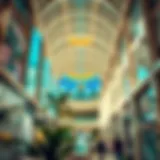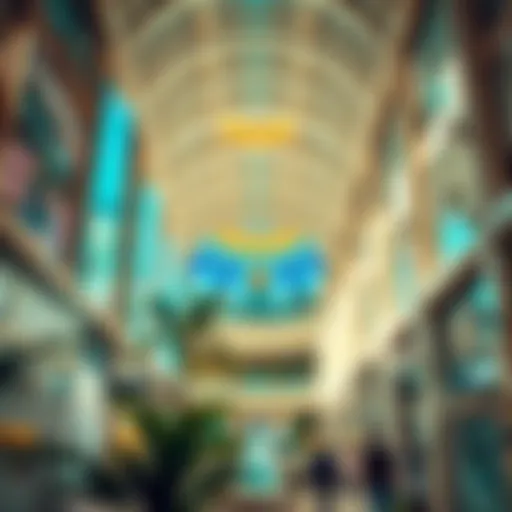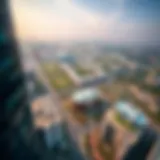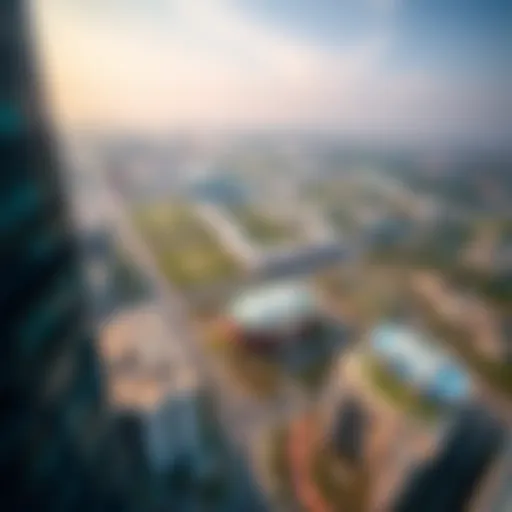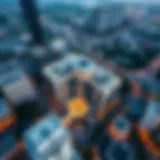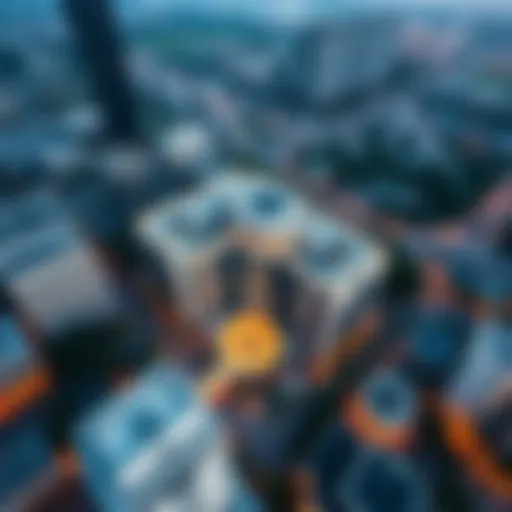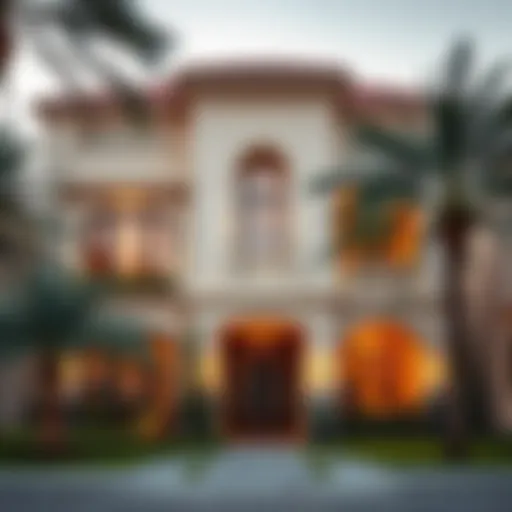Discovering Dubai's Must-See Landmarks and Experiences
Intro
Dubai is a city where ostentation meets modernization, and this duality manifests in its iconic destinations. From the towering Burj Khalifa, which presides over the skyline like a modern-day sentinel, to the tranquil waters of The Dubai Fountain, the city's landmarks are not merely tourist attractions; they are testimonies to the rapid evolution and diversity of this bustling metropolis. This article embarks on a journey to explore the sites that symbolize Dubai's luxurious lifestyle and rich cultural tapestry, aiming to provide a comprehensive understanding of what makes this city a pivotal hub for culture and commerce.
Market Trends and Analysis
Current Market Overview
The real estate market in Dubai has experienced significant changes over the past few years. With an influx of expatriates, there has been a steady increase in demand for residential properties. Areas like Dubai Marina and Downtown Dubai continue to be highly sought after due to their proximity to major attractions and amenities. New developments, such as the Dubai Creek Harbour, are also emerging, aiming to reshape the city's landscape.
Current property prices, while fluctuating, reflect a resilient market overall. Investors have noticed that prime locations offer good returns, particularly in short-term rental markets driven by tourists. As such, understanding these market dynamics is crucial for homebuyers and investors alike.
Future Projections
Looking ahead, various analysts predict a continued growth trajectory for the Dubai market. The government's initiatives, such as visa reforms and infrastructure improvements, are expected to attract even more foreign investment. Additionally, Dubai's positioning as a global hub for events, trade, and tourism suggests that the upward trend in property values is likely to persist.
Given these factors, it may be wise for potential investors to keep an eye on emerging hotspots like Mohammed Bin Rashid City, which is expected to attract diverse demographics, thus enhancing community living standards and property desirability.
"Dubai proves that dreams can surpass expectations when innovation meets ambition."
Investment Opportunities
High-Growth Areas
A keen investor's eye should be on several key areas with notable growth potential:
- Dubai Marina: Widely regarded for its scenic waterfront and leisure facilities, this area continues to attract buyers and renters alike.
- Dubai Creek Harbour: This region is becoming a hot spot with plans for iconic projects and expansive developments, setting the stage for robust property appreciation.
- Jumeirah Village Circle (JVC): Known for its diverse property options, it appeals to families and young professionals, increasing its demand.
Rental Yield Insights
The rental markets in Dubai can offer attractive yields due to its status as a tourist haven. Popular areas often see rental yields ranging between 6% to 10%, making them appealing for buy-to-let investors. Notably, properties in Dubai Marina and Downtown Dubai command higher rental prices, which supports strong yields, but prospective owners should also consider factors such as occupancy rates and seasonal demand fluctuations.
As the city gears up for future developments, investing in real estate in Dubai could be a savvy move, particularly in vetted high-growth areas where demand is outpacing supply. Keeping a pulse on market trends and emerging neighborhoods will provide investors with the insights they need to navigate this dynamic landscape.
For more detailed insights into property investment in Dubai, one might consult resources like Dubai Land Department, a reliable source for real estate data, or explore real estate forums like Reddit for community discussions.
Architectural Marvels
Dubai's skyline is a cornucopia of architectural wonders that both dazzles the eye and reflects the ambition of its residents. It's a testament to human ingenuity and a symbol of the city's rapid development. The architectural marvels of Dubai do not merely serve aesthetic purposes, but they also contribute to the city's economy, tourism, and unique identity. These structures mark the city as a hub of modern design, attracting thousands of visitors who seek to witness this convergence of art and engineering. As local builders and international architects collaborate, they create spaces that are not only functional but also emblematic of a society that values innovation and expression.
Burj Khalifa
Overview of the structure
Standing at a staggering height of 828 meters, the Burj Khalifa is much more than just a skyscraper. It's a symbol of ambition and the relentless spirit of Dubai. As the tallest building in the world, it embodies cutting-edge engineering and design prowess. With its sleek, tapering silhouette, it catches the eye from miles away. The Burj Khalifa serves as a beacon of progress and is a major draw for tourists, contributing significantly to the local economy.
Design and construction details
The design of Burj Khalifa merges both traditional Islamic architecture and ultra-modern aesthetics. The structure was developed by Adrian Smith while at Skidmore, Owings & Merrill. One of the standout features of the building is its triple-lobed footprint, designed to reduce wind forces while maximizing the living spaces. Developed using reinforced concrete, the building’s construction faced numerous challenges, including extreme heat and the logistical hurdles of transporting materials. Nevertheless, it showcases how collaboration between different disciplines can make the impossible, possible.
Visitor experiences
Visitors to the Burj Khalifa are treated to an unparalleled view of the city from the observatory decks on the 124th and 148th floors. The experience is not just about the height; it's also about the journey upwards. The elevator ride itself is a feat of engineering, reaching speeds of 10 meters per second. Once at the top, the breathtaking panorama offers a 360-degree view of Dubai, making it a once-in-a-lifetime experience for many. However, booking in advance is crucial to avoid long lines and to secure a spot during peak times.
Burj Al Arab
Symbol of luxury
The Burj Al Arab is not just a hotel; it’s a bold emblem of luxury that has redefined hospitality. Its unique, sail-shaped design makes it a recognized icon worldwide. Rated as a seven-star hotel, its extravagance draws visitors in droves who seek opulent experiences. From private butlers to helicopter transfers, the Burj Al Arab epitomizes the heights of luxury available in Dubai.
Architectural significance
This hotel's architectural design is not just eye-catching, but it carries significant symbolism as well. Designed by Tom Wright, its striking silhouette is meant to evoke the image of a breaking wave, which resonates deeply with Dubai’s coastal identity. Built on a man-made island, the structure challenges conventional limits of design and construction, pushing the envelope of what is achievable. It’s a landmark that beckons admiration and curiosity from architectural enthusiasts around the globe.
Dining and accommodations
Dining within the Burj Al Arab is an experience tailored for the discerning palate. With restaurants such as Al Muntaha, perched on the 27th floor, serving exquisite culinary delights, visitors can indulge in gourmet dishes while enjoying stunning views of the Arabian Gulf. Moreover, the hotel's lavish suites, adorned with gold leaf and handmade carpets, reflect a standard of living that many aspire to but few can attain. However, it’s important to note that securing a reservation requires a thorough understanding of the booking process as it tends to fill up quickly.
Dubai Frame
Concept and design
The Dubai Frame offers a unique perspective of the past and future of the city. Designed by Fernando Donis, this monumental structure is both a frame and a bridge between two distinct eras of Dubai. Its innovative design invites visitors to step into the past through the lower gallery, while the upper level presents a breathtaking view of the modern skyline. This clever juxtaposition embodies the essence of Dubai: a city perpetually on the edge of the future while honoring its roots.
Visitor insights
For those walking through the Dubai Frame, the experience is more than just visual; it’s also educational. Interactive exhibits within the frame illuminate the city’s transformation over the years, providing context for the rapid development that has taken place. This blend of education and entertainment draws families and history buffs alike, all eager to gain a deeper understanding of Dubai's unique journey. However, the popularity of the attraction can lead to long wait times during peak hours.
Historical context
Construction of the Dubai Frame began in 2013 and was completed in 2018. It represents a significant step in recognizing the city's historical journey from humble beginnings to a global metropolis. The frame serves as both a literal and metaphorical lens through which one can appreciate this evolution. It invites reflection on the delicate balance of progress and heritage, a conversation that is essential in a city that is rapidly changing.
"The architectural landmarks of Dubai are more than structures; they encapsulate the spirit of a city—a narrative of ambition, culture, and timeless elegance."
Overall, these architectural marvels offer a glimpse into Dubai's ambitions and dreams, representing both its luxurious lifestyle and its commitment to innovation. Each site contributes to the unique landscape that distinguishes Dubai from any other city in the world.
Cultural Landmarks
Cultural landmarks play a vital role in defining a city's identity, particularly in Dubai, where history intertwines with modernity. These sites act as gateways, offering insight into the rich heritage and traditions that have shaped the emirate's character. They serve not only as tourist attractions but also as educational platforms that foster understanding and appreciation for the local culture. By exploring these landmarks, visitors gain access to stories that echo through time, allowing them to connect with the past while experiencing the vibrancy of contemporary Dubai.
Dubai Museum
Historical significance
Dubai Museum, located in the Al Fahidi Fort, stands as a testament to the region's growth from a modest fishing village to a bustling metropolis. Established in the late 20th century, this museum is not just a structure; it's a narrative on the evolution of Dubai. A key characteristic of the museum is the authentic artifacts on display that span centuries. Visitors can immerse themselves in the city's pre-oil era, learning about trade, fishing, and the lifestyle of early Emiratis. Moreover, the museum's innovative use of dioramas brings history to life, illustrating daily life with a clarity that books sometimes fail to convey. This aspect makes the museum a compelling choice for anyone seeking to understand the foundations of modern Dubai.
Exhibits and collections
The exhibits at Dubai Museum are both varied and rich, showcasing things from archaeological discoveries to artistic expressions of local culture. A remarkable feature is the traditional Emirati house exhibit, which offers a glimpse into the advancement of local architecture over time. This collection not only highlights the artistic craftsmanship of the region but also serves as an educational tool for understanding how architecture responds to environmental and social changes. The integration of multimedia presentations enhances the experience, laying out the story behind each exhibit while ensuring that even the youngest visitors remain engaged. This unique aspect of the collections emphasizes why Dubai Museum is an essential stop for those interested in the city's culture.
Visitor engagement
Visitor engagement at Dubai Museum has significantly evolved, especially with the introduction of guided tours that cater to diverse audiences. These tours foster an interactive learning experience, allowing guests to ask questions and deepen their understanding. The museum also hosts workshops and family-friendly activities that encourage participation and connection with the exhibits. This aspect enriches the overall visit, enabling individuals to leave with not just memories but a newfound appreciation for Emirati culture. The ability to engage visitors meaningfully makes Dubai Museum a standout in the realm of cultural landmarks.
Jumeirah Mosque
Architectural features
Jumeirah Mosque is regarded as one of the most magnificent examples of Islamic architecture in Dubai. Its intricate design features traditional Fatimid architectural elements, including towering minarets and a grand dome. A distinctive characteristic is its use of white stone, which beautifully contrasts with the deep blue sky, especially during sunset. This structural beauty attracts photographers and architecture enthusiasts alike, presenting a unique visual display that is quintessentially Dubai. Unlike many other mosques, Jumeirah Mosque is open to non-Muslim visitors, making it a beneficial location for those looking to understand Islamic architecture from an insider’s perspective.
Religious importance
The religious significance of Jumeirah Mosque extends beyond its physical beauty. It stands as a center for interfaith dialogue, welcoming visitors of all backgrounds to participate in guided tours. This openness allows guests to gain deeper insights into Islamic practices and the community's values. The mosque provides a platform for discussing cultural differences, promoting a sense of unity among diverse groups. This aspect underscores how culturally relevant the mosque is not only to locals but to the broader international community.
Tours and education
Offering guided tours, Jumeirah Mosque emphasizes education as a core component of its mission. These tours often include discussions about Islamic principles, traditions, and the architectural design itself. An intriguing feature is that many of the guides are local Emiratis who convey personal stories and insights, adding a human element to the experience. This educational focus enriches visitors' understanding and allows them to engage with the mosque on a deeper level. It encourages a respectful dialogue about religion and culture, making it a significant stop for those eager to explore Dubai's cultural landscape.
Al Fahidi Historical Neighborhood
Preservation of heritage
Al Fahidi Historical Neighborhood presents a vivid panorama of Dubai's past, emphasizing preservation efforts that maintain the emirate’s rich cultural fabric. This neighborhood showcases traditional wind-tower architecture, but more importantly, it reflects an effort to uphold the history amid rapid modernization. The key characteristic lies in its narrow lanes and preserved buildings, which transport visitors back in time, illustrating what life might have been like in the 19th century. The commitment to maintaining these structures has made it a popular choice for tourists looking to understand the tapestry of Dubai’s history.
Art and culture spaces
In addition to its historical significance, Al Fahidi has blossomed into a vibrant hub for art and culture. Galleries and cultural spaces dot the area, offering contemporary artworks that dialogue with the old architecture. The neighborhood plays host to workshops and exhibitions that engage artists and entrepreneurs, showcasing the region's creativity and spirit. A unique feature is the ongoing art fairs and festivals, drawing local and international talent, helping to foster a dynamic creative scene. This blend of art and culture makes Al Fahidi a must-visit for those who appreciate the fusion of old and new.
Community activities
Community activities within Al Fahidi foster a sense of belonging and engagement among residents and visitors alike. Events such as cultural festivals, traditional markets, and storytelling nights enhance social ties while celebrating local customs. A noteworthy aspect is the involvement of local artisans and craftsmen, who share their skills through hands-on workshops. This interactive approach promotes an understanding of local traditions, making it more than just a visit; it becomes a shared experience. Such community engagement positions Al Fahidi as a vital landmark, enriching Dubai's cultural narrative.
Entertainment Venues
Entertainment venues are more than just spots to pass the time; they provide a vibrant and engaging atmosphere within Dubai's dynamic landscape. These locations are essential not only for tourism but also for enriching the local culture and economy. With an array of options ranging from shopping centers to theme parks, entertainment venues represent the confluence of luxury, leisure, and innovation. This aspect of the article aims to highlight how these venues elevate the overall experience of visiting Dubai, making it a desirable destination for both tourists and residents.
Dubai Mall
Shopping experience
The shopping experience in Dubai Mall is a tapestry woven with luxury and accessibility. This venue is not only a shopping center but rather a monumental showcase of global brands and local craftsmanship. One key characteristic is its sheer size, being one of the largest malls worldwide; it offers everything from high-end retail to everyday shopping needs. In essence, this shopping experience caters to all, making it a beneficial choice for both visitors and locals alike.
Among its unique features, the mall hosts an underwater aquarium and ice rink, allowing shoppers to enjoy activities beyond mere commerce. However, during peak seasons, the sheer volume of visitors can make the experience feel crowded, detracting from the otherwise luxurious atmosphere. Still, the allure of diverse shopping options continues to draw crowds, solidifying Dubai Mall's spot as a key entertainment venue.
Attractions and entertainment
Attractions and entertainment within Dubai Mall extend beyond shopping. An impressive feature of this venue is the presence of the Dubai Aquarium, which allows visitors to get up close with marine life, making it a favorite for families. Another unique aspect is the indoor theme park, VR Park, which offers virtual reality experiences that are both thrilling and immersive.
This blend of attractions not only entertains but also draws in a variety of demographics, including families, tourists, and adventurous youngsters. However, while the mall boasts an astounding array of activities, it may overwhelm some visitors, making it beneficial to plan visits strategically. Overall, the entertainment offerings enrich the Dubai Mall experience, keeping visitors coming back for more.
Dining options
Dining options in Dubai Mall mirror the diverse palette that Dubai itself offers. From high-end restaurants featuring international cuisine to casual cafes, there's a little something for everyone. A prominent feature worth noting is the range of celebrity chef restaurants that attract food enthusiasts and gourmets alike.
The unique aspect of this dining scene lies in the ambiance; many establishments are designed to provide stunning views of The Dubai Fountain. But with so many dining choices, it can be quite overwhelming for visitors who may have difficulty deciding where to eat. Regardless, the mall's reputation for high-quality dining ensures that a meal here enhances the overall experience of visiting this iconic location.
The Dubai Fountain
Performance mechanics
The mechanics behind The Dubai Fountain's performances are a sight to behold. Designed to shoot water as high as 500 feet, it combines synchronized choreography with music and lights in a spectacular display. A remarkable characteristic of the fountain is its ability to adapt its performance to different musical genres, thereby appealing to a wide audience.
This attention to performance mechanics makes it a beneficial and popular attraction in Dubai, drawing viewers from all around the world. However, the combination of crowds that gather to watch shows can sometimes lead to a struggle for optimal viewing positions. Still, the magical experience of witnessing this grand spectacle often outweighs any minor inconveniences.
Viewing experiences
The viewing experiences at The Dubai Fountain are enhanced by various nearby vantage points. Visitors can choose to watch from the mall, along the waterfront promenade, or even from a boat on the water. This characteristic flexibility allows for more personalized experiences, as audiences can select their vantage points to suit their preferences.
The unique feature of having different locations offers a sense of intimacy, whether one desires a peaceful lakeside view or the excitement of being within the crowd. While popular times can lead to packed spaces, the energy and atmosphere during shows are electric and cannot be rivaled.
Cultural significance
Culturally, The Dubai Fountain holds significance as a landmark that enriches the landscape of Downtown Dubai. Its design represents the deep ties to both Arab heritage and modern aspirations, combining art with technology. This aspect makes it a meaningful choice for understanding the blend of tradition and progression present in Dubai.
The fountain's cultural significance lies in its role as a gathering point, drawing people together and showcasing the collaborative spirit of the city. However, the heavily commercialized environment can sometimes overshadow its artistic connections, leaving some individuals craving a deeper understanding of the artistry involved. Nevertheless, The Dubai Fountain remains an iconic piece of Dubai's cultural representation.
Global Village
Multicultural showcase
Global Village serves as a multicultural showcase, bringing together countries, cultures, and cuisines under one expansive area. This characteristic of cultural amalgamation allows visitors to explore diverse experiences from around the world within a single setting. As such, it is beneficial for understanding the global aspect of Dubai.
With pavilions representing various nations, Global Village presents a unique opportunity for guests to immerse themselves in different customs, crafts, and traditions. This vast assortment can also be overwhelming for first-time visitors seeking to absorb everything. Despite this, the multicultural showcase provides a microcosmic view of the world's diversity.
Food and entertainment
Food and entertainment at Global Village go hand in hand, featuring an array of stands and pavilions where visitors can sample authentic dishes from various cultures. The vibrant aroma of street food fills the air, making it a feast for the senses. Notably, many pavilions put on cultural performances that invite engagement, thriving in the interactive environment.
The unique overlap of diverse culinary offerings and entertainment acts encourages a festive atmosphere. However, the festival-like vibe can be hyperactive, leading some to feel a bit overwhelmed. In this context, the food and entertainment offerings foster community and camaraderie, making Global Village a highlight for many visitors.
Seasonal events
Seasonal events at Global Village are pivotal in drawing crowds all year round. From festive celebrations during the holiday season to themed months showcasing different cultures, these events infuse vibrancy into the venue's atmosphere. A key characteristic of these seasonal festivities is the dynamism they bring, continuously refreshing the experience for returning patrons.
The unique aspect of seasonal events lies in their ability to cater to a wide range of interests, ensuring that there is something for everyone. However, the popularity of these events often leads to larger crowds, necessitating advanced planning to fully enjoy the offerings. Ultimately, the seasonal events at Global Village contribute significantly to its reputation as a must-visit site in Dubai.
Natural Attractions
The natural attractions in Dubai are an essential component of what makes this city so remarkable. While Dubai is known for its luxurious buildings and vibrant nightlife, it also boasts beautiful landscapes that offer both serenity and adventure. The contrast of natural beauty against the backdrop of a sprawling urban environment provides visitors and residents alike with numerous options for exploration and relaxation. Highlighting key elements such as the Palm Jumeirah, Dubai Creek, and the adventurous desert safari allows readers to appreciate the multifaceted nature of Dubai beyond merely its architectural feats.
Palm Jumeirah
Development and structure
Palm Jumeirah stands as a symbol of Dubai's innovative approach to land development. This man-made island, shaped like a palm tree, showcases cutting-edge engineering and design. The success of Palm Jumeirah is evident not only in its aesthetic appeal but also in its ability to create additional waterfront real estate in a city where space is at a premium. The roads and properties are well-planned, promoting a seamless flow of traffic and lifestyle.
"Palm Jumeirah is a testament to human ingenuity, turning a vision into a real oasis."
Its unique structure includes a trunk and 17 fronds, which provide scenic views to the surrounding water. This layout has made it a hotbed for tourism, hospitality, and lavish amenities. However, considerations about sustainability and environmental impact have arisen due to the original dredging activities required to create the island, which can be a disadvantage if not managed adequately.
Resorts and amenities
Palm Jumeirah is also notable for its wealth of lavish resorts and amenities. Hotels like Atlantis, The Palm, offer breathtaking underwater experiences alongside world-class dining. The island's features cater to guests from all walks of life, facilitating a luxurious stay that includes private beaches, spa services, and fine dining options.
One key characteristic is the extensive variety of culinary experiences; visitors can savor flavors from around the world right at their doorstep. While this abundance of options certainly adds to the allure of the location, it can also lead to a perception of exclusivity that may deter budget-conscious travelers.
Environmental considerations
With the development of Palm Jumeirah, environmental considerations are crucial to address. Constructing such a large island necessitated extensive land alteration, which has implications for marine and animal life in the area. Critics have raised concerns regarding potential damage to natural coastlines and ecosystems. However, efforts to mitigate these impacts include conservation programs and sustainable management practices.
Notably, the island includes sea turtle rehabilitation initiatives, which indicate a growing awareness about ecological responsibility. While there are certain advantages to creating a luxurious destination, it’s vital to highlight these environmental aspects to foster a more balanced view of the outcomes of such development.
Dubai Creek
Historical trade route
Dubai Creek has served as a historical trade route for centuries, playing an integral role in shaping the foundations of the city. The creek was once the lifeline of the commerce that helped Dubai evolve from a small fishing village into a bustling trade hub. Its natural harbor allowed for the docking of dhows, facilitating trade with various cultures across the Arabian Gulf.
The historical significance of Dubai Creek makes it a beneficial choice for those looking to understand the city’s rich past. Restoring parts of this area as cultural heritage sites, such as the Dubai Museum, allows visitors to experience the essence of Dubai's origins, providing a counterbalance to its modern persona.
Activities and experiences
Today, Dubai Creek is a bustling center for various activities and experiences, drawing tourists and locals alike. Visitors can enjoy traditional abra rides across the water, exploring the vibrant souks, where spices, textiles, and gold captivate the senses. This area offers an opportunity to revel in both leisure and culture while engaging with the local community.
The variety of experiences available along the creek adds to its popularity, as it allows for a more immersive understanding of Dubai’s cultural tapestry. However, the heavy foot traffic and burgeoning commercial interests sometimes overshadow the historical significance of the area.
Ecological impact
The ecological impact of Dubai Creek cannot be overlooked. While it provides a natural beauty to the urban landscape, human activities have posed threats to its ecosystems. Water pollution from increased tourism and residential developments can adversely affect marine life and the quality of the waterway.
Nevertheless, ongoing efforts to promote sustainability and restore natural habitats illustrate a growing commitment to environmental stewardship in the area. Enhancements to the creek, like planting mangroves, support biodiversity while instilling a sense of responsibility toward preserving this vital resource.
Desert Safari
Adventure activities
Desert safaris are one of Dubai’s prime attractions, offering an exhilarating gateway into the mysterious Arabian Desert. These safaris typically include dune bashing, camel riding, and sandboarding. Such activities allow visitors to experience the thrill of the desert landscape. While adrenaline junkies revel in these adventures, families also find enjoyable options, as many tour operators cater to various age groups and comfort levels.
The uniqueness of desert safaris adds to Dubai’s appeal, allowing travelers to share stories and experiences in a wholly different environment. However, environmental considerations regarding off-road vehicles and the risk of sand erosion must be balanced with the benefits these activities offer.
Flora and fauna
Despite being predominantly arid, the desert is home to an array of flora and fauna that offers fascinating insights into adaptability. From hardy bushes to resilient animals, like the Arabian oryx and sand gazelles, the region's biodiversity is essential to its ecological balance. Educating visitors about these species during safaris enhances appreciation for the delicate ecosystem.
While touring in the desert presents great wonder, over-exposure to certain areas can endanger these plants and animals. Sustainable tourism practices, thus, play a crucial role in ensuring that this unique environment remains intact for future generations.
Tourism impact
The impact of tourism in the desert has been immense, turning what was once a secluded environment into a bustling destination. The growth in safari tours has led to economic benefits, expanding local enterprise and creating jobs. However, the challenge lies in maintaining the delicate balance between harnessing these benefits while ensuring that the environment is preserved for the very allure that draws people to it in the first place.
Modern Innovations
Dubai's rapidly evolving landscape is a testament to its penchant for blending tradition with cutting-edge technology. This section sheds light on the major strides made in modernization, showcasing how these innovations not only elevate the lifestyle of its inhabitants but also enhance the experiences of visitors. The emphasis on modern innovations reflects the city’s ambition to remain at the forefront of urban development.
Dubai Marina
Urban planning
Urban planning in Dubai Marina is nothing short of visionary. This area is meticulously designed to integrate residential, commercial, and leisure spaces into a cohesive environment. The layout emphasizes accessibility and sustainability while providing breathtaking waterfront views. A notable characteristic of this planning is the emphasis placed on mixed-use developments, allowing both residents and tourists to enjoy amenities close to their homes or hotels. One significant advantage of this approach is that it fosters a vibrant community atmosphere, encouraging social interactions among residents.
Residential offerings
The residential offerings in Dubai Marina are diverse, encompassing luxury apartments, penthouses, and townhouses. Each type of residence is designed to cater to different tastes and budgets. A key feature is the panoramic views of the Arabian Gulf, which serves as a unique selling point. Many of these properties come equipped with state-of-the-art facilities, making them a desirable choice for homebuyers and investors alike. However, it’s important to note that the premium rates associated with such luxury living can be a disadvantage for some potential buyers.
Recreational opportunities
Recreational opportunities abound in Dubai Marina, making it a top destination for leisure activities. From water sports to outdoor dining, the marina provides an array of choices for visitors and residents. One of the most appealing aspects is the vibrant nightlife along the waterfront, which includes a plethora of bars and restaurants. This ensures that there is something for everyone, making it a popular spot among all demographics. However, it can also mean crowded spaces, particularly during peak seasons, which may detract from the experience for some.
IMG Worlds of Adventure
Theme park features
IMG Worlds of Adventure stands out as one of the largest indoor theme parks globally, offering a plethora of attractions. The park is divided into themed zones, with rides and experiences inspired by popular cartoons and comic characters. A major draw is the innovative use of technology that enhances the overall guest experience, making the park appealing to families and thrill-seekers. These features contribute significantly to Dubai's reputation as a global entertainment hub. However, guests may find some experiences overwhelming due to the park's scale and visitor numbers.
Visitor demographics
Visitor demographics at IMG Worlds of Adventure show a diverse mix, with families, teenagers, and international visitors all eager to enjoy the attractions. The park draws a particularly young audience, thanks in part to its association with well-known franchises. This wide appeal makes it a large part of Dubai’s tourism industry. Still, peaks in visitor numbers can lead to long wait times for rides, which could deter some guests from returning.
Future expansions
Future expansions at IMG Worlds of Adventure are set to include new rides and attractions, which aim to keep the park fresh and exciting for repeat visitors. Developing unique entertainment experiences is crucial for maintaining its status as a premier destination. The exciting prospect of adding themed zones increases the park's appeal, promising more adventure for families and thrill-seekers alike. On the flip side, such expansions typically require substantial investment and coordination, which may impact the operational logistics temporarily.
Ski Dubai
Indoor skiing experience
The indoor skiing experience at Ski Dubai is a surreal encounter in the desert. This facility boasts real snow, making it not only a winter wonderland but also a hub for skiing and snowboarding in an otherwise arid environment. The main draw, of course, is the opportunity to enjoy winter sports year-round. However, it can be somewhat of a niche experience, attracting those who might have never considered skiing otherwise, also relying on foreign tourists seeking novel experiences.
Technical aspects
The technical aspects of Ski Dubai are impressive, particularly its snow-making capabilities and temperature regulation. High-tech machinery ensures that conditions remain optimal throughout the year, regardless of outside temperatures. This reliability is a significant selling point for both the ski industry and the broader tourism sector in the region. Yet, maintaining such advanced systems requires continuous investment and expertise, which can be challenging.
Visitor attraction
Visitor attraction to Ski Dubai is bolstered by its unique offering in a city known for its heat. Families looking for unconventional leisure activities are drawn to its slopes and snow parks. It stands out in a competitive tourist market, bringing something unexpected to the table. Nevertheless, seasonal demand fluctuations might affect visitor numbers during the hotter months of the year, warranting strategic marketing efforts to keep the momentum going.
"Dubai is not just about luxury; it is about pushing boundaries and creating experiences that are out of this world."
The exploration of modern innovations in Dubai is essential, illustrating the city’s commitment to blending lifestyle, entertainment, and technology. These innovations offer a glimpse into how Dubai has transformed itself into a global city, rich with opportunities for leisure and investment. For homebuyers, investors, and developers alike, understanding these aspects is key to navigating this dynamic landscape.
Shopping Destinations
Shopping in Dubai isn't just a pastime; it's an experience that mirrors the city’s blend of history and modernity. The shopping landscape here is rich and varied, offering everything from traditional souks to luxury malls. This section dives into two standout destinations: Gold Souk and Souk Madinat Jumeirah, each encapsulating a unique aspect of Dubai's vibrant culture and commerce.
Gold Souk
History of the market
Gold Souk stands as a testament to Dubai’s rich trading history, flourishing for decades as a central hub for merchants. Established in the 1940s, this market has deep roots in the cultural and economic fabric of the city. The traders here are known for their age-old practices passed down through generations. The vibrant atmosphere, filled with the glimmer of gold, captures the essence of commerce in Dubai. This market's allure lies in its ability to blend centuries-old selling techniques with modern consumerism.
"Gold Souk holds a mystique unlike any other market, pulling visitors in with its dazzling displays."
Buying gold in Dubai
Purchasing gold in Dubai is not merely a transaction; it is an ingrained tradition. Buyers flock to this souk due to the competitiveness of prices, which is usually lower than in many other countries thanks to Dubai’s zero tax policy on gold. Additionally, the craftsmanship of jewelry pieces is often unique to the region, making each piece more than just a purchase but an investment. The rigorous trade practices also ensure that buyers get value for their money. However, it's worth mentioning that while the bargaining culture thrives here, it can be a bit daunting for first-time buyers.
Local craftsmanship
The hallmark of Gold Souk is the intricate artistry found in its local craftsmanship. Gold jewelry here isn't just about the metal; it's about culture, history, and artistry. Craftsmen utilize techniques that have existed for generations, resulting in pieces that tell stories. With custom designs and local influences, visiting this souk means finding something truly unique. This uniqueness does come with a caveat; while the craftsmanship is commendable, it may carry a premium price compared to mass-produced alternatives.
Souk Madinat Jumeirah
Arabian marketplace concept
Souk Madinat Jumeirah embraces the essence of an Arabian marketplace, but with a modern twist. This venue feels more like a resort than a market, with its winding waterways and traditional architecture. The marketplace concept draws heavily from ancient souks, but here, the focus is also on leisure and ambiance. Visitors find themselves not just shopping, but enjoying the surroundings. The atmosphere mimics an Arabian night, blending shopping with dinning in an elegant setting, which is a sight to behold in itself.
Dining and retail
The dining options at Souk Madinat Jumeirah are as diverse as the shops. Whether you're in the mood for traditional Middle Eastern cuisine or international fare, there's something for everyone. This makes it not only a shopping spot but also a vibrant social hub. The unique blend of dining and retail experiences offers a way to unwind after a day of shopping. However, on the flip side, it might be more expensive than other shopping options in the city, appealing primarily to those looking for a premium experience.
Atmospheric features
Atmospheric features of Souk Madinat Jumeirah play a significant role in attracting visitors. The visual appeal, complemented by beautiful waterways and traditional wind towers, creates an inviting atmosphere for wandering. The intricate details of the interior design reflect local culture, drawing attention away from fast-paced city life. Visitors might find this a double-edged sword, as while the picturesque setting enhances experience, it may lead to larger crowds during peak hours, detracting from the tranquility.
In summary, Dubai’s shopping destinations offer an avenue to experience the city’s character and its blend of history with contemporary charm. From the tradition steeped in Gold Souk to the immersive atmosphere of Souk Madinat Jumeirah, each venue provides its unique narrative contributing to Dubai’s allure as a top-tier destination.
